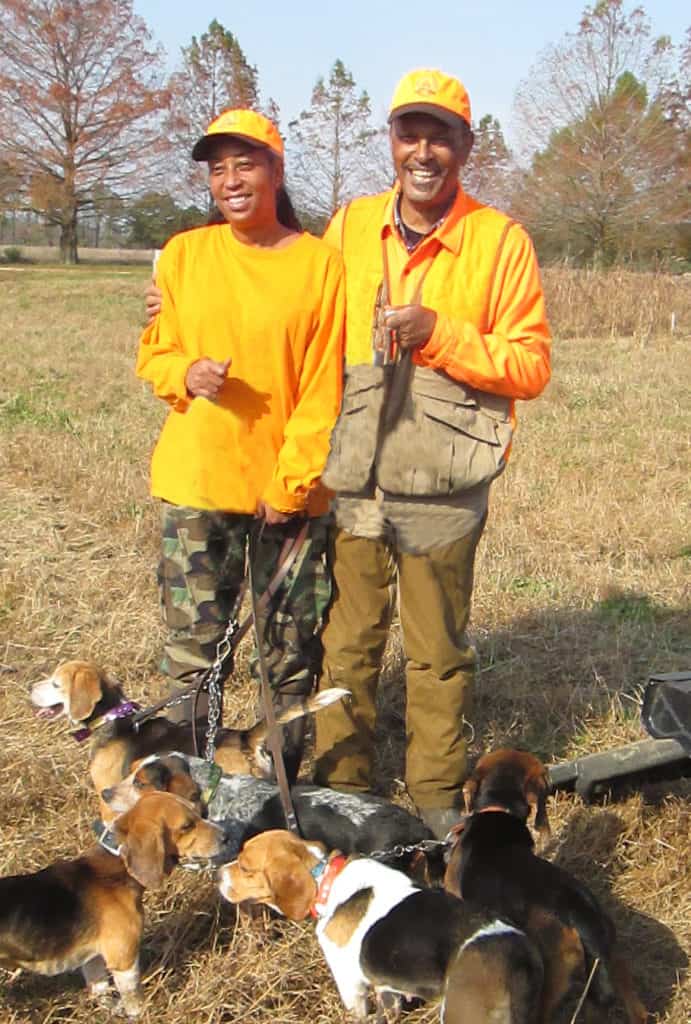Sporting Life

On the Trail of the Wily Cottontail
By Dennis Doyle
Flessiha Noble pulled the buttstock of the slender .410 over/under shotgun into her right shoulder and carefully sighted down the long, narrow rib atop the barrels. With her elbows cocked down at 45-degree angles and her weight shifting forward to her left foot, she picked out the silhouette poised among the weeds on the edge of the Eastern Shore field and tensed slightly.
The sharp blast of the gun as it rocked back against her slight frame had little effect on her, but the practice target, an empty soda can some 15 yards away, tumbled wildly down the field, struck by at least a dozen of the small lead pellets contained in the cartridge.
Noble, 38, a Navy vet and a Dept. of Defense employee, was a lucky woman. A friend of Judy Rodney’s, she had recently become interested in experiencing a wild rabbit hunt for the first time. Judy’s husband is my old friend Charles Rodney, and widely known in the state as The Rabbit Hunter; it was an easy interest to accommodate.
Rodney had invited me along to assist Noble as a rabbit hunt can be a complex affair. One not only has to be safe and adept with firearms, but also familiar with the wily habits of the Eastern cottontail rabbit and the modus operandi of Rodney’s pack of beagles, Hank, Blue, Buckshot, Sam and Sally.
Cottontail rabbits are the main prey of the multiple fur and feathered predators of the Maryland countryside, hawks, eagles, owls, foxes, and the like, and, as such, they are extremely clever and adept at survival. With their long ears, rabbits have excellent directional hearing, a highly developed sense of smell, 360-degree eyesight, are lightning-fast, and extremely agile afoot.
Also on the hunt was Donnie Waters of Salisbury, and the four of us were soon easing into a large, waist-high field, overgrown with weed, briers, and old sorghum stalks. The beagle pack was immediately and loudly unraveling a fresh scent trail.
The cottontail has a home range of about two acres; they can flee danger over wild broken ground at great speed (30 mph) but are generally reticent to leave that familiar territory. When pursued, they will remain anywhere from a dozen feet to 50 yards in front of the dogs and generally circle about in that same two-acre tract where they started, attempting to give the pack the slip. Eventually, they may present a target to one of the hunters stationed about, assuming we have remained still and alert.
Almost 20 minutes passed as we savored the melodies of the five experienced hounds as they stubbornly remained on scent and loudly announced their progress. Both Waters and I had opportunities during that period, but the fleet rascal was well aware of our presence, and we both missed.
Noble then got a glimpse of gray fur, and her gun cracked loudly against the flat terrain, but the crafty devil again remained untouched. Finally, some long minutes later, Rodney got a shot and when his gun sounded, the call “rabbit down” echoed as well.
We continued on, experiencing subsequent chases, misses and successes under brisk, sunny skies, and after we finally put three more of the furry rockets in our bag, we called it a day.
Noble didn’t score this time but it was obvious that she would be back again. As we entered the pickup for the trip home, I noticed that she had casually collected that riddled soda can she had practiced on and placed it in her game pocket. Field memories of a different sort.
Fishfinder:
It’s cold out there with water temps now in the 50s, but there are still fish to be had. Try down deep, 30 feet minimum, for rockfish, with soft jigs or cut menhaden, minnows, or large bloodworms. White perch are on their wintering grounds as well and can be had with bloodworms or small minnows. For both species look around the tributary mouths, Bay Bridge supports, just south of the Eastern Shore rockpile and the mouth of the Eastern Bay. Some big wintering rockfish are just now showing up as well, try trolling and be ready.
